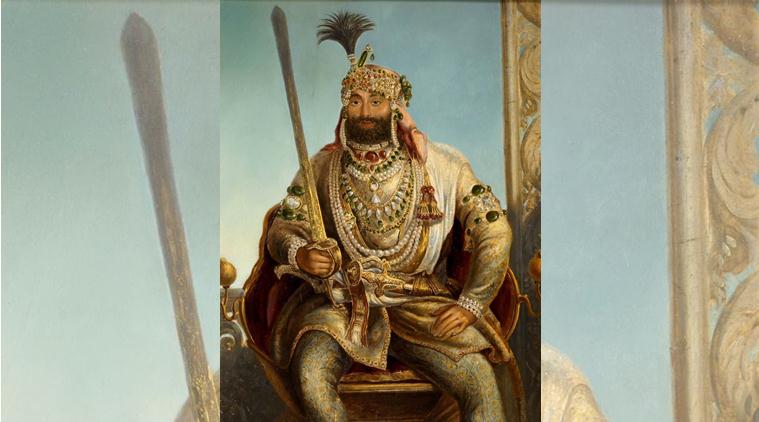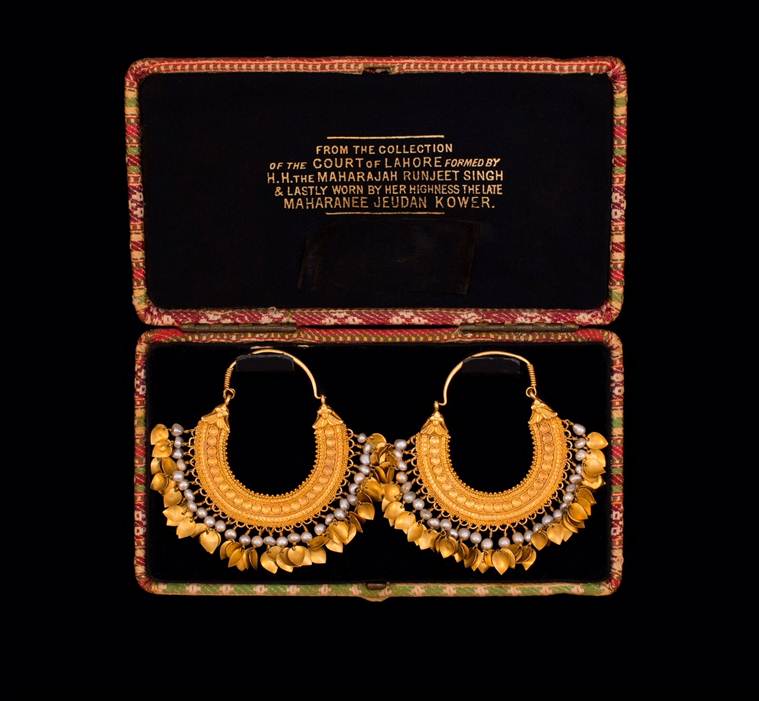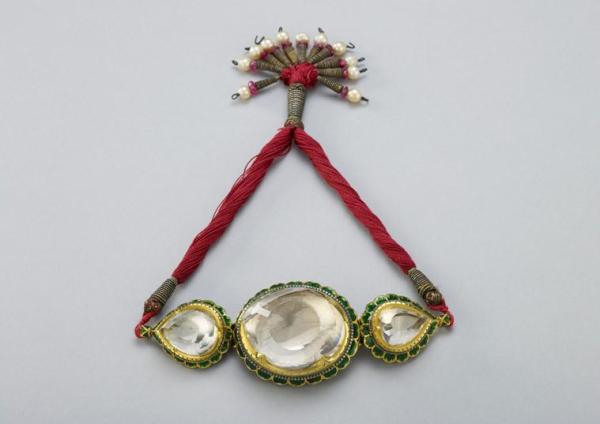 An oil painting in which Maharaja Sher Singh can be seen wearing Kohinoor diamond, Timur Ruby and other precious jewels (1841-42). (Photo: Toor Collection)
An oil painting in which Maharaja Sher Singh can be seen wearing Kohinoor diamond, Timur Ruby and other precious jewels (1841-42). (Photo: Toor Collection)
Empire of the Sikhs- a major exhibition displaying over a hundred objects and artworks related to Sikh warrior Maharaja Ranjit Singh, his family, army and period of kingdom- opened at Brunei Gallery, SOAS in London of the United Kingdom Thursday.
Speaking to The Indian Express, Amandeep Madra, chairman, UK Punjab Heritage Association (UKPHA) said, “It’s the first time that majority of these objects have been on display as many of them are in private collections. Objects and artworks on display include those from the treasury of Maharaja Ranjit Singh, personal items of him and his family, those related to his army, foreign officers he employed and people and trade of undivided Punjab during his kingdom period from 1799-1849.”

Known as Sher-E-Punjab (Lion of Punjab) for his powerful military in his 48 years of reign, his kingdom spread over undivided Punjab (modern day northwest India and Pakistan).
One of the major highlights of the exhibition is the original ‘armlet’ that was worn by Maharaja Ranjit Singh and his son Sher Singh, now fitted with the replica of disputed Kohinoor diamond. “For the exhibition, the armlet has been borrowed from the Queen as it is now a part of the Royal Collection. Maharaja Ranjit Singh had made the armlet especially for Kohinoor and it was handed over to Queen Victoria in 1850. Kohinoor was taken out and the armlet fitted with rock crystal replica is now a part of Royal Collection. It is made in gold, rubies, glass, pearls and silk,” said Madra.
 Gold pendant earrings of Maharani Jinda Kaur, youngest wife of Maharaja Ranjit Singh. (Photo: Toor Collection)
Gold pendant earrings of Maharani Jinda Kaur, youngest wife of Maharaja Ranjit Singh. (Photo: Toor Collection)
Other objects on display include jewellery and weapons from the period of Maharaja Ranjit Singh. A pair of ‘gold pendent earrings’ belonging to Maharani Jind Kaur (Maharaja’s ‘youngest’ wife), which were bought by a UK Sikh- Davinder Singh Toor for Rs 1.69 crore (1,82,000 pounds) during an auction in April this year, is also on display.
A gouache painting of Rani Mahtab Kaur (Maharaja’s first wife) with gold on ivory (1810-30), another gouache depicting scene of court of Maharaja Ranjit Singh at his Lahore fort (1860), a steel and gold sword with Maharaja Ranjit Singh riding an elephant engraved on it (1830-39), an oil painting in which Maharaja Sher Singh is seen wearing Kohinoor diamond, Timur Ruby and precious jewels (1841-42), a photograph of Alexander Gardener wearing a turban, who served as an American mercenary in Maharaja’s army (1864)- are some of the other objects on display. (Years in brackets being estimated creation time).
 A gouache painting of Rani Mahtab Kaur (Maharaja’s first wife) with gold on ivory (1810-30). (Photo: Toor Collection)
A gouache painting of Rani Mahtab Kaur (Maharaja’s first wife) with gold on ivory (1810-30). (Photo: Toor Collection)
An engraving showing Maharaja Ranjit Singh riding a stallion (1838), based on an oil painting commissioned by his trusted Italian officer General Ventura and then gifted to King Louis Philippe of France, is also on display.
Story continues below this ad
Also, a world map titled ‘The Lion’s Firangis’ highlighting the regions from where Firangis (foreigners) came in Maharaja’s court of Lahore was also put on display by UKPHA. “It is for better understanding of visitors and for them to see that from how far people were employed in his kingdom and their origins. We researched details of 73 such foreigners which included Russians, Italians, Spanish, French, Eurasian, American, Anglo-Dutch, Anglo-Indian Greek, German, Irish among others. Of 73, origin of 11 could not be traced,” said Madra.
 – Original armlet which Maharaja Ranjit Singh got crafted to place Kohinoor diamond. (Pic courtesy: UKHPA)
– Original armlet which Maharaja Ranjit Singh got crafted to place Kohinoor diamond. (Pic courtesy: UKHPA)
Madra added, “It’s for the first time that such huge collection of objects and artworks related to Maharaja Ranjit Singh, his wives and his son Maharaja Duleep Singh are on display under one roof. We are getting lot of visitors and response is excellent. Not only Sikhs settled here but UK natives are showing great interest in this exhibition telling the story of Maharaja’s Sikh Empire.”

 An oil painting in which Maharaja Sher Singh can be seen wearing Kohinoor diamond, Timur Ruby and other precious jewels (1841-42). (Photo: Toor Collection)
An oil painting in which Maharaja Sher Singh can be seen wearing Kohinoor diamond, Timur Ruby and other precious jewels (1841-42). (Photo: Toor Collection)
 Gold pendant earrings of Maharani Jinda Kaur, youngest wife of Maharaja Ranjit Singh. (Photo: Toor Collection)
Gold pendant earrings of Maharani Jinda Kaur, youngest wife of Maharaja Ranjit Singh. (Photo: Toor Collection) A gouache painting of Rani Mahtab Kaur (Maharaja’s first wife) with gold on ivory (1810-30). (Photo: Toor Collection)
A gouache painting of Rani Mahtab Kaur (Maharaja’s first wife) with gold on ivory (1810-30). (Photo: Toor Collection) – Original armlet which Maharaja Ranjit Singh got crafted to place Kohinoor diamond. (Pic courtesy: UKHPA)
– Original armlet which Maharaja Ranjit Singh got crafted to place Kohinoor diamond. (Pic courtesy: UKHPA)

























